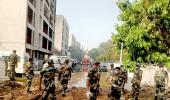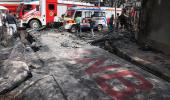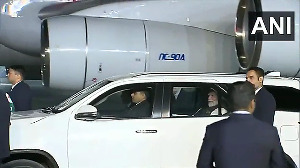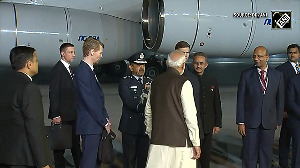'In those 10 seconds, they even made a MAYDAY call -- which is only issued in case of a serious, imminent emergency.'

From flying MiGs in the Indian Air Force to investigating fatal air crashes as part of India's first AAIB team, Captain Kishore Chinta has seen aviation from cockpit to crash site.
Now Chief Pilot at Sirius India Airlines, Capt Kishore tells Rediff why viral speculation around AI 171's landing gear, electrical system and Ram Air Turbine (RAT) is premature -- and technically misleading.
- Part 1: 'Even Something Small Could Hold Clues'
- Part 2: 'Nowhere In The AAIB's Mandate Is The Apportioning Of Blame'
What kind of personal background checks are part of this AAIB investigation?
Investigators will talk to families of the crew -- was there any stress, what time did they sleep, which hotel, what food they had, whether they had alcohol. Every detail is examined.
Pilots' training records will be requested -- some media have already sensationalised this -- but it is a routine part of the process.
The AAIB will compile records such as simulator performance, date of last simulator session, license validity, renewal dates -- every document.
Isn't that just standard procedure?
The minute list of details -- it's all part of their job. They're just doing the job. No need to sensationalise it.
It's like saying tomorrow AAIB calls the Director of Flight Operations of Air India and says, 'Please provide us this, this, this information.' The next headline would read: 'AAIB summons Director of Flight Operations.'
That's how it's made to sound sensational.
What's your own background in air crash investigation?
All that I have described in this interview is absolutely normal and part of the process (of AAIB's investigations). I've done it. And just to clarify, I've done two investigations -- both CAT I accidents. One was fatal, and one was a total hull loss of the aircraft.
I haven't done a lot of them, but yes, I've undergone accident investigation training under the aegis of the DGCA when the AAIB was being formed for the first time in 2012.
A lot of industry professionals were called to undergo ICAO Level 2 Extended Investigation Course under DGCA's guidance. All of us were then on the AAIB panel for the first three years, as it was just starting up and formulating more rules and regulations.
I was part of that initial group. That's my background. So I don't want to hoodwink or sensationalise anything.
So in the case of AI 171, the emergency backup system -- technically called the RAT or Ram Air Turbine -- was reportedly deployed. What does that suggest, if at all?

Here's what: When the aircraft is on the ground, it receives power either from a Ground Power Unit (GPU) or the Auxiliary Power Unit (APU), which is a mini engine located in the tail -- where you see that small exhaust at the back of the aircraft.
The APU powers everything when the aircraft is on the ground. So it's either the GPU or the APU.
Once the engines start, the engine generators take over and supply power to all systems.
Now, when the aircraft is airborne, if the engines stop turning, those engine generators stop working.
When that happens, modern aircraft -- including the Dreamliner -- have a system called the Ram Air Turbine (RAT), which deploys automatically if the generators fail to supply power.
It is triggered by generator failure, not necessarily engine failure. People often misunderstand this. These are two different systems.
If the generator's output drops below its minimum tolerance, say it's supposed to deliver 26 volts ± 2 volts, and it drops below 24 volts, then the RAT would automatically deploy. It doesn't wait for a complete failure -- it's a pre-emptive safety feature.
Now, there's no conclusive evidence yet that the RAT deployed. It's still speculation. First it was about flaps, now it's the RAT. Even if the RAT didn't deploy or didn't provide sufficient power, the aircraft still has main batteries. These can supply power for up to 30 minutes.
So it's (deployment of RAT or the movement of flaps) not the grave emergency and people are making it out to be. The idea that the RAT deployed and therefore there was an electrical failure, leading to engine shutdown is nonsense -- a bunch of nonsense.
Right now, there's no conclusive evidence it (the RAT) deployed. Some are circling dark spots in videos or referencing sounds. But that's circumstantial and speculative. Whether it did deploy will be confirmed only once the AAIB downloads the flight data recorder.
Is it also speculation that the landing gear was extended?
It's clear the landing gear remained extended. There could be many reasons for that.
On average, after wheels leave the ground, it takes about 3 to 4 seconds for the vertical speed indicator to show a positive climb. The co-pilot will call out 'Positive Rate,' and the pilot flying will respond with 'Gear Up.' It's a sequence.
Based on videos, flight radar data, and ADS-B data, we estimate the aircraft was airborne for about 32 seconds -- from wheels up to impact. About 10 to 12 seconds were spent climbing, and after that it reportedly began descending.
Let's break it down. If it takes 3 to 4 seconds to confirm a positive rate of climb, and the co-pilot calls out 'Positive Rate,' then the captain calls 'Gear Up,' that whole sequence takes about 5 seconds. That would leave just a few more seconds before any warning might have come in.
Now imagine some warning pops up. It takes time to process the warning, identify the issue, and initiate corrective action -- all at a very critical stage of flight.
Based on their training, pilots must assess the warning and decide on a response. It takes time.
Ten seconds is nothing. It's the blink of an eye. And in those 10 seconds, they even made a MAYDAY call -- which is only issued in case of a serious, imminent emergency. That indicates something very critical happened.
So in 10 to 12 seconds, a lot may have gone wrong. But it's far too early to definitively say what.










